Alex Bledsoe's Blog, page 37
March 21, 2011
Review: Alice Hoffman's The Red Garden
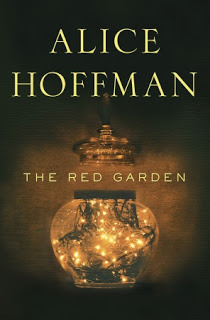
If Alice Hoffman was a painter, her brush strokes would barely touch the canvas, yet her pictures would be as vivid as Monet's. She crafts delicate stories that always seem on the verge of wafting away until they come back to earth with some devastating, perfect detail.
The Red Garden is something new from her: a book pitched somewhere between a short story collection and a novel. The individual tales stand more or less on their own, but the cumulative effect is much more novelistic. The continuing character is Blackwell, a Massachusetts town that she tracks from its settling in 1750 through the present day. Founded by a woman so tough and determined that she milks a bear to keep the settlers alive, the town remains home to strong-willed women who either choose duty over love, or find love's solace fleeting. The men are often confused, aimless, seeking a direction in life that many of them find in the wilderness of the nearby mountain. Bears are a recurring motif, as are bees and eels in the river. The titular garden grows plants that inevitably turn red for reasons that the reader knows, but not the inhabitants.
And there are elements of overt magic, specifically in the story "The Fisherman's Wife." But for the most part, the supernatural elements remain subtle, hidden, easily explained to the characters with more mundane explanations. Only the reader, with the perspective of history, sees them for what they truly are. And it's that gentle, cobweb-light push/pull of magic and reality that defines the book's tone.
Stylistically, Hoffman goes for something equally subtle. Characters weave in and out of the stories, and Hoffman plays with narrative voice when it suits her ("The Truth About My Mother," for example, is told in first person). There's a sense that the penultimate story, "The Red Garden," resolves threads left from the very first tale, "The Bear's House." But then there's a final story, "King of the Bees," that thematically says no story ever ends, not even when we think we understand it. Blackwell's tales go on, just as life continues past our own moments of epiphany.
As a reader, I try to expose myself to things vastly different from what I write. The Red Garden has virtually nothing in common with my own stories, but I hope it teaches me to be a hair more subtle, or to risk a moment of delicacy amongst the swordplay and carnage.
Published on March 21, 2011 02:56
March 15, 2011
The Rio Bravo approach to world-building
I'm often asked about "world building," the term for creating the environment for fantasy novels. Most tend to be much more elaborate than mine, which may be one reason why my books are so much shorter. I usually respond with some variation of, "I'm more interested in people building," which is true but can understandably sound a bit facile.
Still, I can't deny I'm far more interested in the details of character than in aspects of society that don't impinge on the story. So I cast about for another example of that approach, and found it in one of my favorite movies, Howard Hawks' classic western Rio Bravo starring John Wayne, Dean Martin and Ricky Nelson.
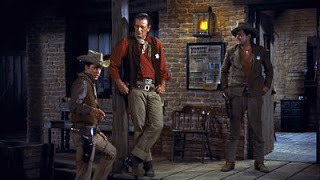
The setting is as generic a Western town as you can imagine: it's nameless (although it's assumed to be "Rio Bravo," no one ever actually says so), isolated, and the only institutions shown are the jail, the hotel and the saloon. Contrast this to the unique, incredibly detailed sets of The Wild Bunch or the specific geographical settings of The Searchers. At the time (1959) television was filled with Western series the way we now have reality shows, and nothing about Rio Bravo's setting is substantially different from the backlot towns people saw every week for free on Bonanza, Gunsmoke and Have Gun, Will Travel. So what did the movie have to make them pay to see it?
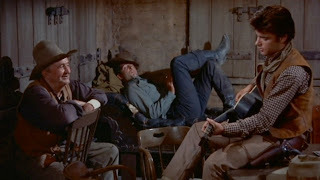
Characters. Archetypal to be sure, but developed with detail and skill, played by actors at the top of their games and laced through with humor. In other words, the exact opposite of world-building. People-building. And if I have to err, that's the direction I'd rather go. I can live with an underdeveloped or generic setting, as long as it's populated by compelling and interesting characters.
What do you think? How much setting is enough, and how much is too much?
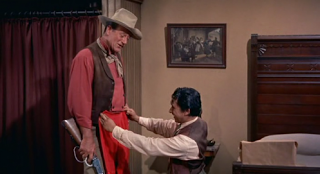
Admit it: this picture really makes you want to see the movie, doesn't it?
Still, I can't deny I'm far more interested in the details of character than in aspects of society that don't impinge on the story. So I cast about for another example of that approach, and found it in one of my favorite movies, Howard Hawks' classic western Rio Bravo starring John Wayne, Dean Martin and Ricky Nelson.

The setting is as generic a Western town as you can imagine: it's nameless (although it's assumed to be "Rio Bravo," no one ever actually says so), isolated, and the only institutions shown are the jail, the hotel and the saloon. Contrast this to the unique, incredibly detailed sets of The Wild Bunch or the specific geographical settings of The Searchers. At the time (1959) television was filled with Western series the way we now have reality shows, and nothing about Rio Bravo's setting is substantially different from the backlot towns people saw every week for free on Bonanza, Gunsmoke and Have Gun, Will Travel. So what did the movie have to make them pay to see it?

Characters. Archetypal to be sure, but developed with detail and skill, played by actors at the top of their games and laced through with humor. In other words, the exact opposite of world-building. People-building. And if I have to err, that's the direction I'd rather go. I can live with an underdeveloped or generic setting, as long as it's populated by compelling and interesting characters.
What do you think? How much setting is enough, and how much is too much?

Admit it: this picture really makes you want to see the movie, doesn't it?
Published on March 15, 2011 02:28
March 9, 2011
Read the first chapter of DARK JENNY
Published on March 09, 2011 06:20
March 7, 2011
Reality...what a (necessary) concept
Reality may seem a strange concern for a writer who focuses on fantasy and horror. After all, how can you claim anything is "real" in tales of faux-medieval warriors, disco-era vampires and supernatural hillbillies? Yet it's an overwhelming concern to me, and one that leads me repeatedly back to the films of John Cassavetes.
His work--among them Shadows, Faces, the seminal A Woman Under the Influence, my current favorite Opening Night--created the American independent film movement. Their sometimes ragged natures are often perceived as the result of improvisation, in the same vein as the films of Christopher Guest or Henry Jaglom, but that's a misperception: Cassavetes may have based his screenplays on rehearsal improvisations, but the final films are the result of tightly scripted and deliberately constructed performances. Within them, of course, are moments of invention, but not so many as you might think.
This approach is made clear in A Constant Forge, a lengthy (140 minutes) documentary by Charles Kiselyak. Cassavetes died in 1989, so the majority of the interviews are with people who worked with him, along with excerpts from print interviews read by Sean Penn. It's also obvious in Cassavetes Directs, a fly-on-the-wall account of the filming of his last movie, Love Streams, in 1984.
So what's the point of this approach? Simply, it allows an almost total breakdown of the line between performance and documentary realism. There are moments in A Woman Under the Influence that feel so real, so uncomfortably genuine, that even with famous actors like Peter Falk and Gena Rowlands onscreen, you can forget you're watching a movie and feel like you're spying on real people. For an audience used to dramatic signposts (THIS is a serious scene, THIS is a humorous line, you should feel TERROR here), a movie like this can be a hugely uncomfortable experience.
So what can a prose writer get from this? I hope it serves as a reminder that no matter what's happening in the story, whether your hero is facing a dragon or a vampire is learning that sunlight will not destroy her, the reality of the moment lies in reactions that are unanticipated but undeniably genuine. In Cassavetes' work, he strove to get beneath the surface responses people give, the "performances" that get us through real life, in order to present something original that the audience nevertheless responds to as genuine. As writers, we should do the same. As writers of fantasy, horror and science fiction, it should be a priority.
Here's a clip of Cassavetes in action, talking about the release of Opening Night but finally going off on some interesting tangents.

His work--among them Shadows, Faces, the seminal A Woman Under the Influence, my current favorite Opening Night--created the American independent film movement. Their sometimes ragged natures are often perceived as the result of improvisation, in the same vein as the films of Christopher Guest or Henry Jaglom, but that's a misperception: Cassavetes may have based his screenplays on rehearsal improvisations, but the final films are the result of tightly scripted and deliberately constructed performances. Within them, of course, are moments of invention, but not so many as you might think.
This approach is made clear in A Constant Forge, a lengthy (140 minutes) documentary by Charles Kiselyak. Cassavetes died in 1989, so the majority of the interviews are with people who worked with him, along with excerpts from print interviews read by Sean Penn. It's also obvious in Cassavetes Directs, a fly-on-the-wall account of the filming of his last movie, Love Streams, in 1984.
So what's the point of this approach? Simply, it allows an almost total breakdown of the line between performance and documentary realism. There are moments in A Woman Under the Influence that feel so real, so uncomfortably genuine, that even with famous actors like Peter Falk and Gena Rowlands onscreen, you can forget you're watching a movie and feel like you're spying on real people. For an audience used to dramatic signposts (THIS is a serious scene, THIS is a humorous line, you should feel TERROR here), a movie like this can be a hugely uncomfortable experience.
So what can a prose writer get from this? I hope it serves as a reminder that no matter what's happening in the story, whether your hero is facing a dragon or a vampire is learning that sunlight will not destroy her, the reality of the moment lies in reactions that are unanticipated but undeniably genuine. In Cassavetes' work, he strove to get beneath the surface responses people give, the "performances" that get us through real life, in order to present something original that the audience nevertheless responds to as genuine. As writers, we should do the same. As writers of fantasy, horror and science fiction, it should be a priority.
Here's a clip of Cassavetes in action, talking about the release of Opening Night but finally going off on some interesting tangents.
Published on March 07, 2011 02:38
February 28, 2011
Hundreds of little people living under his skin.*
Coming up with character names is, as the master Charles Dickens probably knew, one of the most fun aspects of writing. Unlike real life, where you're named long before your identity is formed, you have the chance to give someone a handle that reflects their personality. Villains can be named "Uriah Heep"; plucky young urchins can be "Pip" or "The Artful Dodger"; Doomed girls can be "Little Nell." For a current master of this sort of thing, check out the films of Larry Blamire (for example, in The Lost Skeleton of Cadavra his alien couple is named "Kro-Bar" and "Lattis.").
But sometimes naming gets...tricky. As I've said elsewhere, I first invented my Eddie LaCrosse character in high school, except back then I named him "Devaraux LaCrosse." It was my attempt to play the high-fantasy, high-falutin' name game so prevalent in the genre of the time. My villain, who ultimately bore the much more reasonable monicker "Andrew Reese," was then known as "Kakorian Shay." Now, there's nothing inherently wrong with these ten-dollar names, I suppose, and perhaps a better writer could've made them work. But my bad guy certainly benefitted from a more normal name, and my hero never truly came alive for me until he started answering to the much less grandiose "Eddie."
In another, so far unfinished work, I used a placeholder name for the heroine, simply because I didn't want to stop writing long enough to think of the right one. "Bailey Nichols" was a play off a character from WKRP in Cincinatti, Bailey Quarters (Quarters/Nichols, quarters/nickles, get it?). There was no reason for this association within my story, which is a Southern Grand Guignol set during the eighties; consciously at least, it was entirely arbitrary. But as I worked on it, the name "Bailey Nichols" suddenly seemed to fit. I can't say for sure if it was merely the familiarity of repetition, but I was no longer able to think of her under any other name. So Bailey Nichols she remains.
Sometimes names present themselves, and there's no question they're right. Fauvette, the heroine of Blood Groove, was named after the song of the same name by Duncan Browne, whose music accompanied my writing process. She never had another name. The same with Bronwyn, protagonist of my upcoming novel The Hum and the Shiver. However, the names of the vampire sisters in The Girls with Games of Blood, Prudence and Patience, were arrived at by a deliberate process of pairing up names in search of ones that looked, sounded and felt right.
I started thinking about these issues after reading about another writer, Chelsea Main, whose critique group recommended she change the name of her protagonist. It turns out my response to "Bailey Nichols" wasn't unique. Chelsea said, "To me, names are not arbitrary labels for my characters. Names carry meaning and symbolism. The feel of a name says a lot about a character's personality to me. Choosing the correct name is a big deal - and letting go of one I've become attached to is not easy."
So what are your favorite character names, both from other's work and, if applicable, your own? Everyone who replies here will have a shot at my last remaining ARC of Dark Jenny.
*Full quote: "Every human being has hundreds of little people living under his skin. The talent of a writer is his ability to give them their separate names." (Mel Brooks)
But sometimes naming gets...tricky. As I've said elsewhere, I first invented my Eddie LaCrosse character in high school, except back then I named him "Devaraux LaCrosse." It was my attempt to play the high-fantasy, high-falutin' name game so prevalent in the genre of the time. My villain, who ultimately bore the much more reasonable monicker "Andrew Reese," was then known as "Kakorian Shay." Now, there's nothing inherently wrong with these ten-dollar names, I suppose, and perhaps a better writer could've made them work. But my bad guy certainly benefitted from a more normal name, and my hero never truly came alive for me until he started answering to the much less grandiose "Eddie."
In another, so far unfinished work, I used a placeholder name for the heroine, simply because I didn't want to stop writing long enough to think of the right one. "Bailey Nichols" was a play off a character from WKRP in Cincinatti, Bailey Quarters (Quarters/Nichols, quarters/nickles, get it?). There was no reason for this association within my story, which is a Southern Grand Guignol set during the eighties; consciously at least, it was entirely arbitrary. But as I worked on it, the name "Bailey Nichols" suddenly seemed to fit. I can't say for sure if it was merely the familiarity of repetition, but I was no longer able to think of her under any other name. So Bailey Nichols she remains.
Sometimes names present themselves, and there's no question they're right. Fauvette, the heroine of Blood Groove, was named after the song of the same name by Duncan Browne, whose music accompanied my writing process. She never had another name. The same with Bronwyn, protagonist of my upcoming novel The Hum and the Shiver. However, the names of the vampire sisters in The Girls with Games of Blood, Prudence and Patience, were arrived at by a deliberate process of pairing up names in search of ones that looked, sounded and felt right.
I started thinking about these issues after reading about another writer, Chelsea Main, whose critique group recommended she change the name of her protagonist. It turns out my response to "Bailey Nichols" wasn't unique. Chelsea said, "To me, names are not arbitrary labels for my characters. Names carry meaning and symbolism. The feel of a name says a lot about a character's personality to me. Choosing the correct name is a big deal - and letting go of one I've become attached to is not easy."
So what are your favorite character names, both from other's work and, if applicable, your own? Everyone who replies here will have a shot at my last remaining ARC of Dark Jenny.
*Full quote: "Every human being has hundreds of little people living under his skin. The talent of a writer is his ability to give them their separate names." (Mel Brooks)
Published on February 28, 2011 03:00
February 21, 2011
Bad Influences from Good Sources
As writers, we all own up (or should) to the things that influence us in a positive way. For example, I acknowledge the debt I owe to Robert B. Parker for my understanding of how to make a first-person narrative entertaining. But what about negative influences? What about the things that we tried to incorporate into our own writing that turned out to be huge, big mistakes?
I have two examples from my own career. One is Joe R. Lansdale's Drive In novels, particularly The Drive-In 2: Not Just One of Them Sequels. I read this one in the late 80s, when I was trying to develop my own voice and style, and it completely threw me off course for what turned out to be several years. It wasn't just that I liked the style, which I did up to a point; it was that it was so different from my own work, I took it as a sign that I was doing everything wrong. Clearly sincerity and forthrightness weren't what people wanted; they wanted irony and robust humor (I was half right, as the subsequent rise of uber-ironic Joss Whedon proved). What I missed was the meta-level of Lansdale's work, which was far more important than either the irony or the farting tyrannosaurs. So I spent years--no kidding, years--trying to work in a style for which I was entirely unsuited, and which I completely misunderstood. It was probably 1994 before I regrouped, found my own voice and began producing things that, whatever their overall merit, at least sounded like me.
The second example is the Martin Scorsese film The Color of Money, with a screenplay by novelist Richard Price. At the climax, veteran pool shark Fast Eddie Felson (Paul Newman) finds himself about to shoot a game against his own protege, Vincent Lauria (Tom Cruise). The whole film seems to have come down to this game, and the audience is breathless to see who will win. That is, until this exchange of dialogue:
Vincent: Eddie, what are you gonna do when I kick your ass?
Eddie: Pick myself up and let you kick me again.
Vincent: Oh, yeah?
Eddie: Yeah. Just don't put the money in the bank, kid, 'cause if I don't whip you now, I'm gonna whip you next month in Dallas...And if not then, then the month after that in New Orleans.
Vincent: Oh, yeah? What makes you so sure?
Eddie: Hey--I'm back! (shoots the break, screen fades to black)
This final minute of film completely realigns the story we've just watched. What seemed to be a standard, if well-done sports drama about the fall of the old and rise of the new becomes, in that moment, a story of the reclaimed self-awareness of Fast Eddie Felson. It's significant that we never even see the results of the break Eddie shoots, because in that moment the game of nine-ball, the whole impetus of the story thus far, becomes immaterial. Much like the first Rocky, it no longer matters who wins the game, because that's never been the real story. Only unlike Rocky, Scorsese and Price manage to hide that from us until literally the last minute.
I saw this as a challenge. I resolved to make every story I wrote hinge on this sort of twist, which is a whole lot trickier than it first appears. I think I only succeeded once, in a so-far-unpublished short story about jaguar hunters in South America. My other stories from this period left readers with a sense of "Huh? What?" Luckily I came to realize that the film's ending worked so well because it was unexpected, unusual, and rare. The moment people start expecting a twist at the end, whatever you come up with lost its potency (this was also later proved true by the flame-out of twist-meister M. Night Shyamalan). So I went back to writing stories that ended appropriately for themselves, which often meant just as the reader expects. That's not always a bad thing.
So let's hear from some other writers. Who influenced you in what turned out to be a bad way?
I have two examples from my own career. One is Joe R. Lansdale's Drive In novels, particularly The Drive-In 2: Not Just One of Them Sequels. I read this one in the late 80s, when I was trying to develop my own voice and style, and it completely threw me off course for what turned out to be several years. It wasn't just that I liked the style, which I did up to a point; it was that it was so different from my own work, I took it as a sign that I was doing everything wrong. Clearly sincerity and forthrightness weren't what people wanted; they wanted irony and robust humor (I was half right, as the subsequent rise of uber-ironic Joss Whedon proved). What I missed was the meta-level of Lansdale's work, which was far more important than either the irony or the farting tyrannosaurs. So I spent years--no kidding, years--trying to work in a style for which I was entirely unsuited, and which I completely misunderstood. It was probably 1994 before I regrouped, found my own voice and began producing things that, whatever their overall merit, at least sounded like me.
The second example is the Martin Scorsese film The Color of Money, with a screenplay by novelist Richard Price. At the climax, veteran pool shark Fast Eddie Felson (Paul Newman) finds himself about to shoot a game against his own protege, Vincent Lauria (Tom Cruise). The whole film seems to have come down to this game, and the audience is breathless to see who will win. That is, until this exchange of dialogue:
Vincent: Eddie, what are you gonna do when I kick your ass?
Eddie: Pick myself up and let you kick me again.
Vincent: Oh, yeah?
Eddie: Yeah. Just don't put the money in the bank, kid, 'cause if I don't whip you now, I'm gonna whip you next month in Dallas...And if not then, then the month after that in New Orleans.
Vincent: Oh, yeah? What makes you so sure?
Eddie: Hey--I'm back! (shoots the break, screen fades to black)
This final minute of film completely realigns the story we've just watched. What seemed to be a standard, if well-done sports drama about the fall of the old and rise of the new becomes, in that moment, a story of the reclaimed self-awareness of Fast Eddie Felson. It's significant that we never even see the results of the break Eddie shoots, because in that moment the game of nine-ball, the whole impetus of the story thus far, becomes immaterial. Much like the first Rocky, it no longer matters who wins the game, because that's never been the real story. Only unlike Rocky, Scorsese and Price manage to hide that from us until literally the last minute.
I saw this as a challenge. I resolved to make every story I wrote hinge on this sort of twist, which is a whole lot trickier than it first appears. I think I only succeeded once, in a so-far-unpublished short story about jaguar hunters in South America. My other stories from this period left readers with a sense of "Huh? What?" Luckily I came to realize that the film's ending worked so well because it was unexpected, unusual, and rare. The moment people start expecting a twist at the end, whatever you come up with lost its potency (this was also later proved true by the flame-out of twist-meister M. Night Shyamalan). So I went back to writing stories that ended appropriately for themselves, which often meant just as the reader expects. That's not always a bad thing.
So let's hear from some other writers. Who influenced you in what turned out to be a bad way?
Published on February 21, 2011 03:12
February 14, 2011
Lancelot du Lac: hiding meaning in plain sight
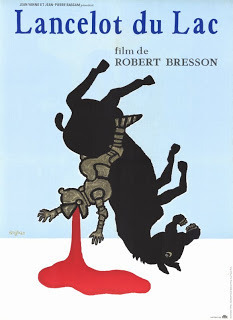
Recently I blogged about how John Boorman's 1981 film Excalibur awakened my love for Arthurian stories. And while I continue to adore that film, I've also grown to love its polar opposite, an Arthurian film so minimal, as stark as Excalibur is voluptuous, that it's hard to believe they basically tell the same tale: Robert Bresson's 1974 film Lancelot du Lac. I grew to love it during the time I was researching and writing Dark Jenny, so you might find its influence in my latest Eddie LaCrosse novel.
Bresson, like Boorman, created a cinematic body of work notable for its extremes. He seldom used real actors, instead looking for faces that expressed the soul of his characters (he termed his performers "models"). Then he bled any sort of overt emotion from their performances, resulting in flat, declarative line readings. This may sound boring, but it's actually the opposite: with so much space between the words' meaning and their expression, the viewer is drawn in, supplying the emotions the film deliberately omits.
The film is in French, appropriate for a story of Lancelot, who was added to the Arthurian canon by French writers. It begins with a series of ridiculously over-the-top conflicts involving blood that spurts like it's being shot from a hose (and yes, a possible inspiration for Monty Python's "Black Knight"), followed by a stirring, martial main theme:
(The first three minutes of the film.)
This is kind of a bait-and-switch, though, because the film proper is almost inert by comparison. The Knights of the Round Table return to Camelot after failing to find the Holy Grail, and Lancelot attempts to break free of his love for Queen Guinevere. Guinevere insightfully tells him, "It was not the Grail. It was God you all wanted. God is no trophy to bear home." But this is little consolation for the decimated, downhearted knights, and before long Lancelot and Guinevere are back in each other's arms.
Everything in the film is low-key, and that's a crucial part of its effectiveness. The knights wear their armor constantly, and the soundtrack is alive with its creaks and clangs. Horses whinny in terror, whether from new frights or memories of the Grail quest. The central action scene, a jousting tournament, is shot using shadows and oblique angles so that the individual knights fail to take on any individuality. Books could be written on what all this means symbolically (and certainly chapters in books have been, as well as many scholarly articles), but they add up to probably the bleakest Camelot ever put on film.
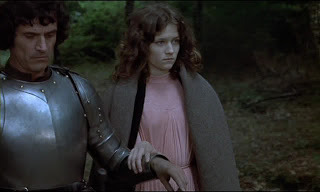
(Lancelot [Luc Simon] and Guinevere [Laura Duke Condominas])
And yet the relationships at the core of the story remain true to what we've come to accept as the legend. Arthur is still king, Gawain is still torn between loyalties, Mordred skulks in the shadows plotting treason. Merlin is long dead, and there's no Morgan le Fay, but this isn't a movie about that kind of magic anyway.
Instead, to me it's a film about hiding: behind armor, behind vows, behind despair. Lancelot competes in a joust wearing a disguise. The failure of the Grail quest leads Arthur to hide behind prayer. Guinevere hides her love for Lancelot. And Bresson hides the story's tragic heart beneath the flat performances and skewed frame of his brilliant film.
Published on February 14, 2011 02:42
February 7, 2011
Return of the REAL King
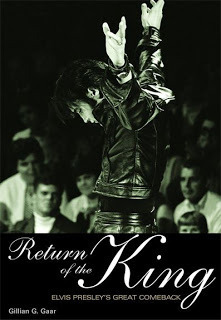
There are many books on Elvis, from treatises on his sociopolitical influence to muckraking autobiographies by those on his payroll, but it's rare to find one that understands his impact, yet takes the time to delve into the human being behind it. Gillian Gaar's Return of the King does just that, using as her sources mainly interviews with musicians and others who worked with Elvis from just prior to his 1968 comeback TV show through his death in 1977. This is not a book that tells how a simple boy from Tupelo turned into a sex symbol and superstar; instead, this explains how the acknowledged King of Rock and Roll briefly took back his career and showed a jaded Sixties audience just why he was the King.
The arc of Elvis' career is well known: hillbilly cat, Army service, movie star, Vegas act, bloated corpse on the bathroom floor. It's in that gap between "movie star" and "Vegas Act" that Gaar begins, detailing Elvis' dissatisfaction with his career and the music he was forced to record. Elvis was the very embodiment of the saying, "Wham, Bam, Thank You Ma'am," combining unsettling sexuality with Southern politeness, and it was the latter quality that kept him from breaking free of people like Colonel Tom Parker, the manager who had guided his rise but had no interest in insuring his continued growth as a performer and artist. But eventually even Elvis had enough, and he supported TV auteur Steve Binder in the creation of a TV show that was much more than the Colonel's intended simple "Christmas special."
Gaar devotes her pages exclusively to what other biographers deal with only in passing: the creation of the music. There are riveting accounts of recording sessions from the musicians who played them, revealing the disheartening reality of Elvis' career. This makes his moments of triumph all the more powerful, because he had to overcome the very machinery that supposedly created him in the first place. What comes through is both Elvis' humanity, his kindness and decency to the players he worked with, and the loneliness that a man surrounded only by payroll sycophants can truly feel.
(One non-musical highlight is the account of Elvis' meeting with then-president Richard Nixon, as related by members of Nixon's staff and Elvis' inner circle. What is often depicted as a possibly drug-addled adventure becomes clearly a moment of utter showing-off by the King, for a surprising reason.)
I've read a lot of books about Elvis, and this is one of the few that makes no apologies for either his accomplishments or his failures. Gaar does not pass judgment, and although she does imbue her tale with authorial sympathy, she doesn't gloss over failures both musical and personal. If you've ever wondered why Elvis mattered, you'll understand after reading Gaar's book.
Published on February 07, 2011 02:11
January 31, 2011
Io9, Battlestar Galactica, and the American Idol culture
"Born Originals, how comes it to pass that we die Copies?"--"Conjectures on Original Composition" by Edward Young, 1759
***
I'll tell you up front, this is a rant. I try not to do them often, and usually delete them after I write them. If you're reading this one, it means I'm still fuming even after an acceptable cooling-off period.
Io9, the go-to website for SF news, recently ran this article by site managing editor Charlie Jane Anders about Ron Moore's "bible" for the series Battlestar Galactica. In these notes for series writers, Moore claims he's after "nothing less than the reinvention of the science fiction television series."
That's all well and good, except for one thing: it was a remake. All the heavy lifting of creating the concepts, the basic spaceship designs, the names of characters and their home planets, even the all-purpose curse word "frak," was done by Glen A. Larson back in the seventies. Whatever you may think of the original show (and you won't hear me sing its praises, believe me), you have to acknowledge that Moore is, in effect, putting a new coat of paint on the house Larson built. Painting a house is hard, but it's not nearly as hard as building one from scratch. Or even more harshly, you could say that Moore is pissing off of Larson's shoulders, and judging from the article's final line--"And it's definitely a reminder how fresh and exciting the show was when it launched."--there's quite a few people standing below with their mouths open.
That's a crude judgment of creators and fans, I realize. People are entitled to make what they want, and like what they want. But goddamn, people. In her review of the movie Burlesque for Entertainment Weekly, Lisa Schwarzbaum nails it: "[In] these American Idol times...we agree to pretend that mediocre mimicry of better artists is good enough to keep us entertained." I make no case for the original Battlestar, but its remake is certainly not unique or different enough to count as "the reinvention of the science fiction television series"; it may not be mediocre mimicry, but it's still mimicry.
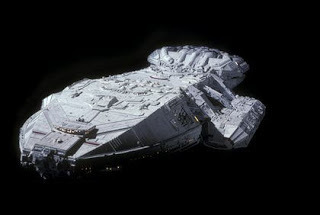
(Glen A. Larson's Battlestar...)
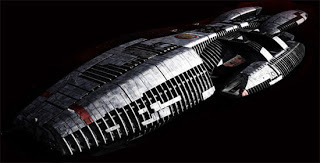
(...and Ron Moore's "totally reinvented" Battlestar)
If Ron Moore really wanted to reinvent the science fiction television series, he could've taken the original Battlestar as an inspiration and come up with his own ideas for setting, backstory, names, etc. In other words, he could've MADE UP HIS OWN SHOW. It's okay to 'fess up to being influenced; everyone has influences. To claim originality while doing a remake is both inane and arrogant. But really, what frustrates me most is that he's being celebrated by an audience that apparently doesn't know or care what originality is. Anders barely acknowledges the new show's status as a remake; the article in question is even headlined, "The original Battlestar Galactica series bible..." To paraphrase Douglas Adams, this must be a definition of "original" with which I was previously unfamiliar.
In a New York Times article on rethinking "open source" culture, Jaron Lanier may have pegged the origin and continuing source of this level of cannibalism. "It's as if culture froze just before it became digitally open, and all we can do now is mine the past like salvagers picking over a garbage dump."
The next logical step--praising salvagers as creators--has apparently begun as well. For a generation now coming of age, they literally have no concept of what constitutes "creation." Mash-ups, remakes and "re-imaginings" are all they get. And, if Moore can be praised for essentially claiming he built a house that he only repainted, they may never know the joy of encountering something truly original.
Well, except for Pixar.
Since I ranted here, feel free to rant back at me in the comments.
***
I'll tell you up front, this is a rant. I try not to do them often, and usually delete them after I write them. If you're reading this one, it means I'm still fuming even after an acceptable cooling-off period.
Io9, the go-to website for SF news, recently ran this article by site managing editor Charlie Jane Anders about Ron Moore's "bible" for the series Battlestar Galactica. In these notes for series writers, Moore claims he's after "nothing less than the reinvention of the science fiction television series."
That's all well and good, except for one thing: it was a remake. All the heavy lifting of creating the concepts, the basic spaceship designs, the names of characters and their home planets, even the all-purpose curse word "frak," was done by Glen A. Larson back in the seventies. Whatever you may think of the original show (and you won't hear me sing its praises, believe me), you have to acknowledge that Moore is, in effect, putting a new coat of paint on the house Larson built. Painting a house is hard, but it's not nearly as hard as building one from scratch. Or even more harshly, you could say that Moore is pissing off of Larson's shoulders, and judging from the article's final line--"And it's definitely a reminder how fresh and exciting the show was when it launched."--there's quite a few people standing below with their mouths open.
That's a crude judgment of creators and fans, I realize. People are entitled to make what they want, and like what they want. But goddamn, people. In her review of the movie Burlesque for Entertainment Weekly, Lisa Schwarzbaum nails it: "[In] these American Idol times...we agree to pretend that mediocre mimicry of better artists is good enough to keep us entertained." I make no case for the original Battlestar, but its remake is certainly not unique or different enough to count as "the reinvention of the science fiction television series"; it may not be mediocre mimicry, but it's still mimicry.

(Glen A. Larson's Battlestar...)

(...and Ron Moore's "totally reinvented" Battlestar)
If Ron Moore really wanted to reinvent the science fiction television series, he could've taken the original Battlestar as an inspiration and come up with his own ideas for setting, backstory, names, etc. In other words, he could've MADE UP HIS OWN SHOW. It's okay to 'fess up to being influenced; everyone has influences. To claim originality while doing a remake is both inane and arrogant. But really, what frustrates me most is that he's being celebrated by an audience that apparently doesn't know or care what originality is. Anders barely acknowledges the new show's status as a remake; the article in question is even headlined, "The original Battlestar Galactica series bible..." To paraphrase Douglas Adams, this must be a definition of "original" with which I was previously unfamiliar.
In a New York Times article on rethinking "open source" culture, Jaron Lanier may have pegged the origin and continuing source of this level of cannibalism. "It's as if culture froze just before it became digitally open, and all we can do now is mine the past like salvagers picking over a garbage dump."
The next logical step--praising salvagers as creators--has apparently begun as well. For a generation now coming of age, they literally have no concept of what constitutes "creation." Mash-ups, remakes and "re-imaginings" are all they get. And, if Moore can be praised for essentially claiming he built a house that he only repainted, they may never know the joy of encountering something truly original.
Well, except for Pixar.
Since I ranted here, feel free to rant back at me in the comments.
Published on January 31, 2011 02:10
January 24, 2011
Low Road: Donald Goines and urban tragedy
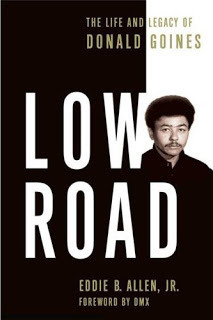
I discovered the novels of Donald Goines when I worked for a book distributor that sold collections to libraries. Often this meant orders for all the books by a particular author, as was the case with Goines, whose novels bore vivid titles like Whoreson, Black Gangster, Swamp Man and White Man's Justice, Black Man's Grief. Goines' first novel appeared in 1971, and he died in 1974 at age 37 after writing sixteen books, a meteoric career by any standards. And they're all still in print today.
Low Road: The Life and Legacy of Donald Goines is an attempt to put his life and accomplishments into the context of their specific times. Occasionally it seems like author Eddie B. Allen, Jr. is more interested in the context than the man, but ultimately his approach pays off. Allen describes the Detroit in which Goines grew up, as well as the racial situation throughout the country. Goines, son of a successful middle-class black family, faked his way into the air force at fifteen, served in Korea and returned at seventeen a veteran and heroin addict. He tried careers as pimp and hustler, served time in prison and then, inspired by former pimp turned literary darling Iceberg Slim, decided to pursue writing. He wrote what he knew, but he wrote with a blinding honesty and the kind of grit you can't fake. His street hustlers weren't glamorous or admirable, and even when they tried to do the right thing, they still had past sins that needed atonement. But it was more than a transcription of his own experience; these were stories, crafted and polished, by a man who too late discovered his true calling.
It isn't until the penultimate chapter, "Prodigal Son," that Allen goes in depth into Goines' work, connecting characters and situations among the books, and with Goines' own life. Here he presents an analysis of what Goines tried to accomplish, his motivations and why he connected with readers. The first Goines novel I read, Swamp Man, turns out to be an anomaly, set in Mississippi and dealing with a brother's revenge for his sister's degradation at the hands of repulsive rednecks. The rest of Goines' output is urban and concerned mainly with survival, although a little vengeance gets had as well.
Oddly Allen, also a Detroit native like his subject, seems unable to fully accept that Goines, untrained and unschooled, could have simply imagined the stories, going into great depths to find real-life sources and qualifying observations with statements like, "[Goines] might not have intended it, but the symbolism in the story is conspicuous." Or, "Whether Donnie did it consciously or without thought, he gave several different characters in his books identical names." This skepticism seems strange in a book about a man who, we assume, fascinated Allen enough to write about him.
(I think this is the profound lesson of Goines' work to other writers: the fact that you don't need formal training, no MFA or fancy residency in Iowa. You can simply decide be a writer. The technical skills will come with practice and help, but the core drive requires nothing but the desire to tell a story uniquely your own [and figuring out that part can be harder than it sounds]. Goines had that desire, which is why we still remember him.)
Still, Allen does a good job of presenting Goines' ouvre in detail, qualified or not. In the epilogue, he explains his own connection to Goines, his attempts to solve the writer's 1974 murder (no one was ever arrested or charged), and thoughts on Goines' legacy from academics.
There is, ultimately, a lot of Allen in the book. Whether this detracts from the reading experience is something for each reader to decide. It didn't bother me; it was like having a tour guide, and given the areas that the book explores, it was handy to have someone along who knew the territory. Ultimately Low Road gives as much insight into Goines as we're likely to get at this late date, and if the man remains an enigma to the reader, it's probably because he was one to himself as well.
Published on January 24, 2011 02:54



